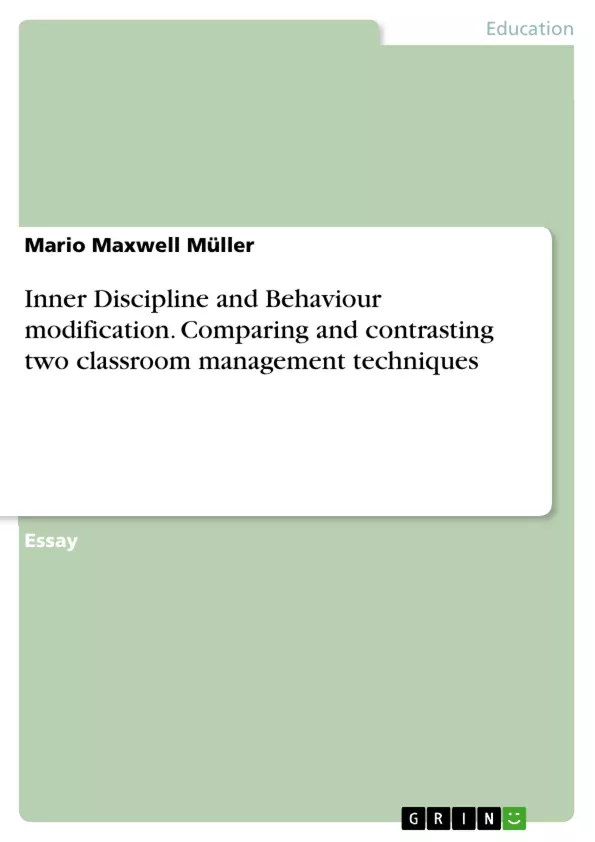The following essay discusses the use of two contrasting models which include inner discipline and behaviour modification focussing on the theories and work of Barbara Coloroso and Burrhus Frederic Skinner, where students have the ability to show awareness for discipline when teachers are using the correct strategies and considering their feelings and actively involving them in the process. It is imperative for teachers to use a variety of strategies to promote a positive, safe and stimulating educational environment for them to flourish and reach their full potential.
Inhaltsverzeichnis (Table of Contents)
- Introduction
- The Low-control/Guiding Model
- Self-Regulating Approach
- High-control/Intervening Model
- Behaviour Modification Approach
Zielsetzung und Themenschwerpunkte (Objectives and Key Themes)
This essay compares and contrasts two classroom management models: inner discipline (a self-regulating approach) and behavior modification. The objective is to analyze the theories underpinning each model, highlighting their practical applications and implications for creating positive classroom environments. The essay draws on the work of Barbara Coloroso and B.F. Skinner.
- Classroom management strategies
- Comparison of inner discipline and behavior modification
- The role of student agency in learning
- Creating positive and stimulating learning environments
- Teacher styles and their effectiveness
Zusammenfassung der Kapitel (Chapter Summaries)
Introduction: This introductory section sets the stage by recounting the author's personal experiences with classroom dynamics and the impetus for exploring contrasting classroom management models. It introduces the core concepts of inner discipline (Barbara Coloroso) and behavior modification (B.F. Skinner) as tools for improving classroom strategies and overall management. The author highlights the need for diverse strategies to foster positive learning environments.
The Low-control/Guiding Model: This chapter delves into a low-control, guiding model characterized by high levels of encouragement and support for students struggling academically. The model emphasizes considering students' feelings, perceptions, and opinions when implementing discipline. It rests on the belief that students possess the capacity for self-control and personal growth, making their preferences central to classroom management. The core principles of this model lay the groundwork for the subsequent discussion of the self-regulating approach.
Self-Regulating Approach: This section focuses on Barbara Coloroso's self-regulating approach, defining it as a collaborative process between teachers and students, aiming to foster self-discipline rather than imposing external control. Lynch (2018) is cited to emphasize that discipline should be restorative and invite reconciliation. The author highlights the advantages and disadvantages of this approach, acknowledging its potential to empower students while potentially presenting challenges for less experienced teachers. The concept of "brick-wall," "jellyfish," and "backbone" teachers is introduced to illustrate differing teaching styles and their impact on student behavior.
High-control/Intervening Model: This chapter introduces B.F. Skinner's behavior modification approach, contrasting it with the self-regulating model. It emphasizes the influence of external factors on student behavior, suggesting that teachers should shape behavior by reinforcing desired actions and addressing inappropriate ones. The chapter lays the groundwork for a detailed examination of behavior modification techniques in the following section.
Behaviour Modification Approach: This section defines behavior modification as targeting observable behaviors for change, emphasizing the role of reinforcement and consequences in shaping student actions. Goldstein & Mather (2001) are cited to highlight the principles of reinforcement and how consequences modify classroom behavior. This section provides the concluding perspective on behavior modification in contrast to the previously discussed self-regulating approach.
Schlüsselwörter (Keywords)
Inner discipline, behavior modification, Barbara Coloroso, B.F. Skinner, classroom management, self-regulating approach, positive classroom environments, student agency, teacher styles, discipline strategies.
Frequently Asked Questions: A Comprehensive Language Preview
What is the main topic of this language preview?
This language preview provides a comprehensive overview of a text comparing and contrasting two classroom management models: a low-control/guiding model emphasizing inner discipline (a self-regulating approach) and a high-control/intervening model using behavior modification. It analyzes the underlying theories, practical applications, and implications for creating positive learning environments.
What classroom management models are discussed?
The preview focuses on two contrasting models: The low-control/guiding model, which promotes self-regulation and student agency, and the high-control/intervening model, which utilizes behavior modification techniques. The low-control model draws heavily on the work of Barbara Coloroso, while the high-control model is rooted in the theories of B.F. Skinner.
Who are the key theorists mentioned?
The preview prominently features the work of Barbara Coloroso (inner discipline, self-regulating approach) and B.F. Skinner (behavior modification). Additional researchers, such as Lynch (2018) and Goldstein & Mather (2001), are cited to support specific aspects of the models.
What are the key themes explored in the text?
Key themes include classroom management strategies, a comparison of inner discipline and behavior modification, the role of student agency in learning, creating positive learning environments, and the impact of different teacher styles on student behavior. The concepts of "brick-wall," "jellyfish," and "backbone" teachers are used to illustrate varying teacher approaches.
What are the chapter summaries?
The preview includes summaries for each chapter: An introduction setting the stage and outlining the core concepts; a chapter on the low-control/guiding model emphasizing student support and self-control; a section detailing Coloroso's self-regulating approach; a chapter introducing Skinner's behavior modification approach; and a section explaining the principles of behavior modification, including reinforcement and consequences.
What are the objectives of the text?
The text aims to compare and contrast the two classroom management models, analyze their underlying theories, explore their practical applications, and discuss their implications for fostering positive classroom environments. It seeks to highlight the importance of considering student agency and teacher styles in creating effective learning environments.
What are the keywords associated with this text?
Keywords include: Inner discipline, behavior modification, Barbara Coloroso, B.F. Skinner, classroom management, self-regulating approach, positive classroom environments, student agency, teacher styles, and discipline strategies.
What is included in the language preview?
This comprehensive language preview includes the title, table of contents, objectives and key themes, chapter summaries, and keywords. It provides a structured and professional overview of the text's content, suitable for academic analysis.
- Citation du texte
- Dr Mario Maxwell Müller (Auteur), 2021, Inner Discipline and Behaviour modification. Comparing and contrasting two classroom management techniques, Munich, GRIN Verlag, https://www.grin.com/document/1292829



